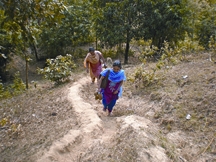Garo Hill
Garo Hill refers to an east-west trending hill range situated at the northwestern part of the country and is conglomerate of three districts viz., East Garo Hills, West Garo Hills and South Garo Hills. The hill range stretches out between 28°08' N to 26°01' N latitude and 89°50' E to 90°59' E longitudes. The total area of the three districts is 8167 Sq. Kms. Garo Hills is bounded in south by Mymensing district and a part of Rangpur district of Bangladesh, by a district of Assam on the North and the West and by the West Khasi Hills District of Meghalaya in the east. The Garo Hills comprise parts of the Garo-Khasi range in Meghalaya, India. The range is part of the Meghalaya subtropical forests ecoregion. Shillong, the capital of Meghalaya, is located in this range. Garo Hills comprises 3 districts, Tura, Balpakram and Nokrek. Tura is the largest town with a population of about 70,000 located at the foothills of Tura peak. It is one of the wettest places in the world. The weather, calm and quite environment and panoramic beauty of the countryside with hill and river is really charming.

The longest river in Garo Hills is Simsang. Simsang River originates from Nokrek. It is situated at an altitude of 1,400 metres above sea level. Simsang flows through the East Garo Hills and South Garo Hills Districts. The notable attraction on the banks of this river includes Sisolbibra, Siju Caves, Baghmara etc. The river, as it passes along various courses springs up to a beautiful waterfall, of all shades, which has a unique tale of its origin.
Garo Hills in Meghalaya is perhaps world's most preserved biodiversity region. It boasts of many water bodies, deep dense forests, rare flaura and fauna and Balpakram National Park. Garos' have a unique knowledge about land use and preservation. Though the forest cover over the years may have declined, still vast stretch of the land is covered with deep dark forest. People living in this hill are very hospitable, warm and welcoming. Their lifestyle and culture portray their love for nature. Their comfortable coexistence with nature is evident from the folk songs and dances of the region. [Sanzida Murshed and Kazi Matin Uddin Ahmed]
